Birding is a popular pastime in Louisiana for both residents and visitors. It is home to a wide variety of bird species, including several rare and endangered species.
The Louisiana landscape also offers a variety of bird habitats, including coastal marshes and pine forests. Furthermore, the mild climate of the state makes birding possible year-round.
Birders are also attracted to Louisiana’s culture. In Louisiana, birding offers a unique experience with its Cajun and Creole cuisine, music, and festivals.
Birders will find Louisiana an ideal destination whether they are searching for rare birds or just enjoying a day outdoors.
What Ducks Are in Louisiana?
These are the ducks that call Louisana home.
Black-bellied Whistling-duck
Bufflehead
Canvasback
Cinnamon Teal
Common Goldeneye
Fulvous Whistling-duck
Gadwall
Mallard
Northern Shoveler
Redhead
Ring-necked Duck
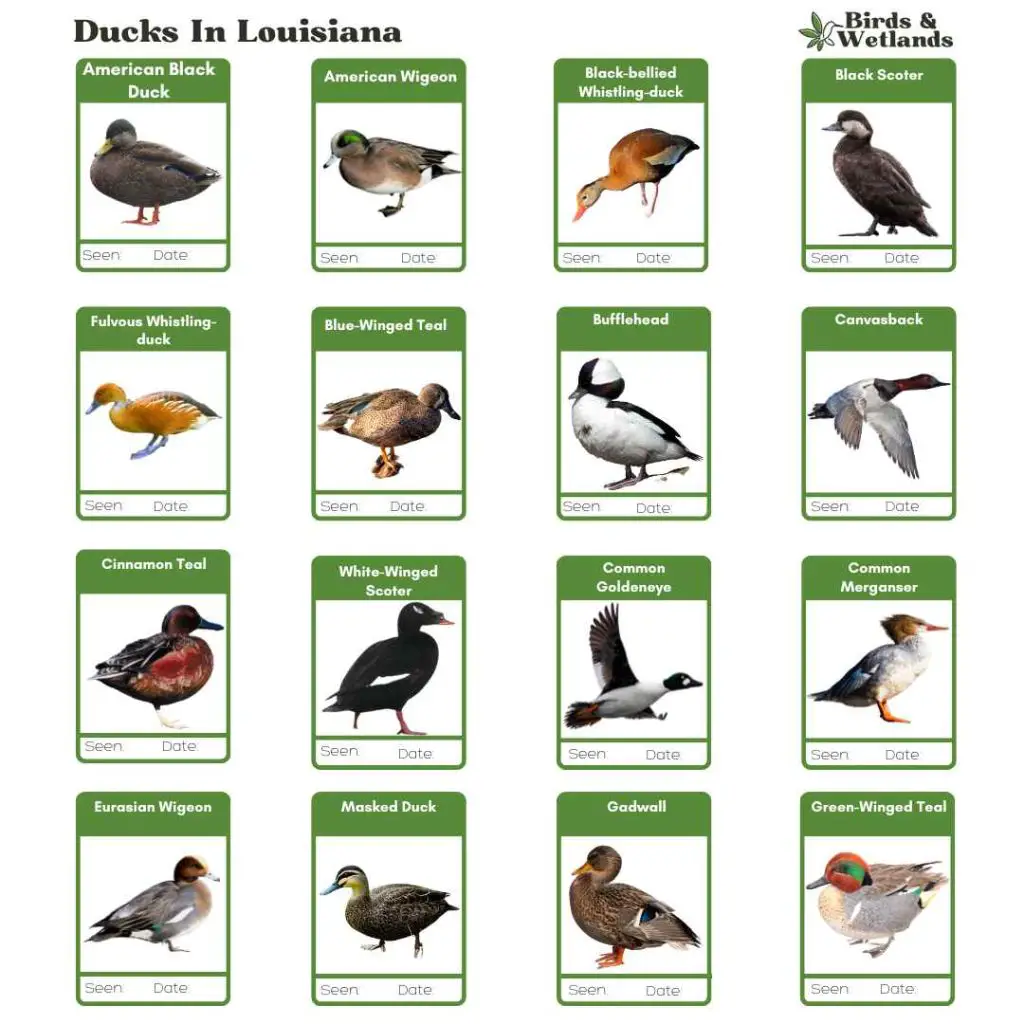
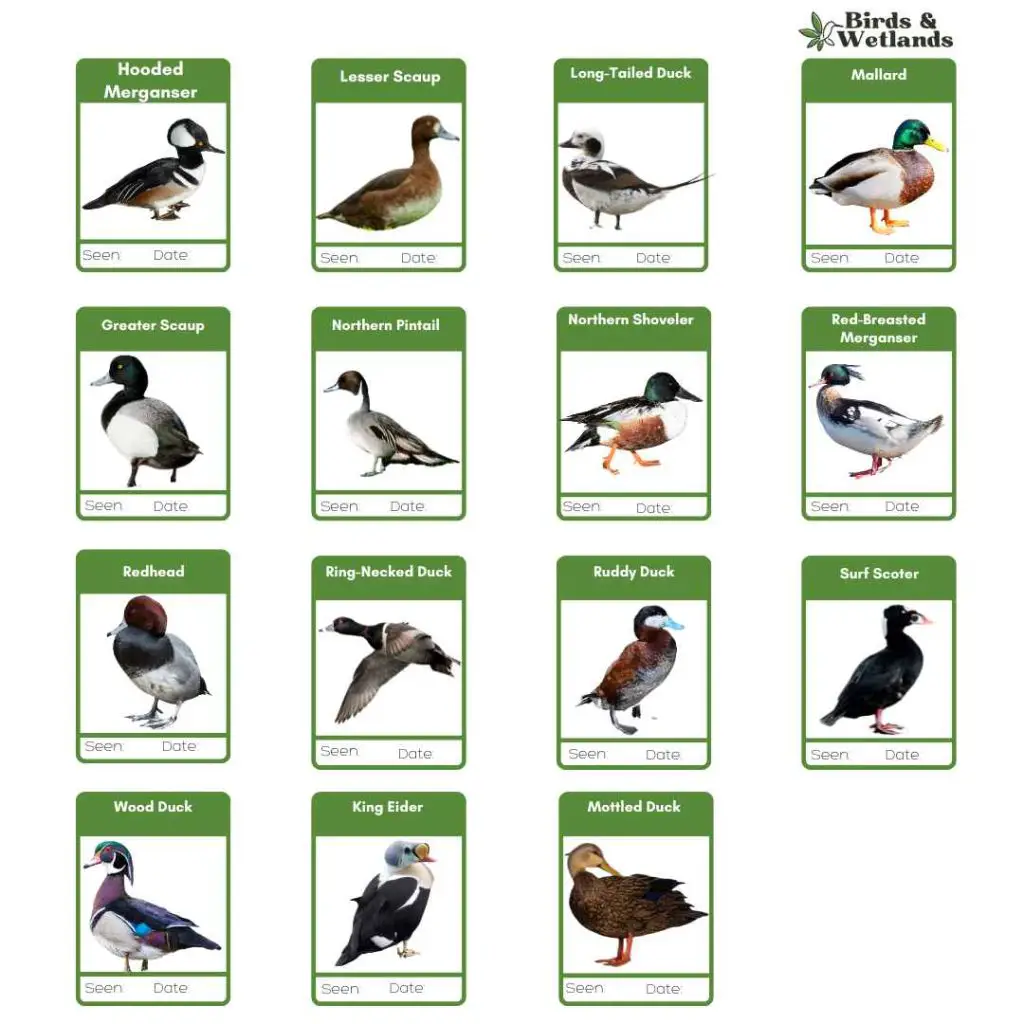
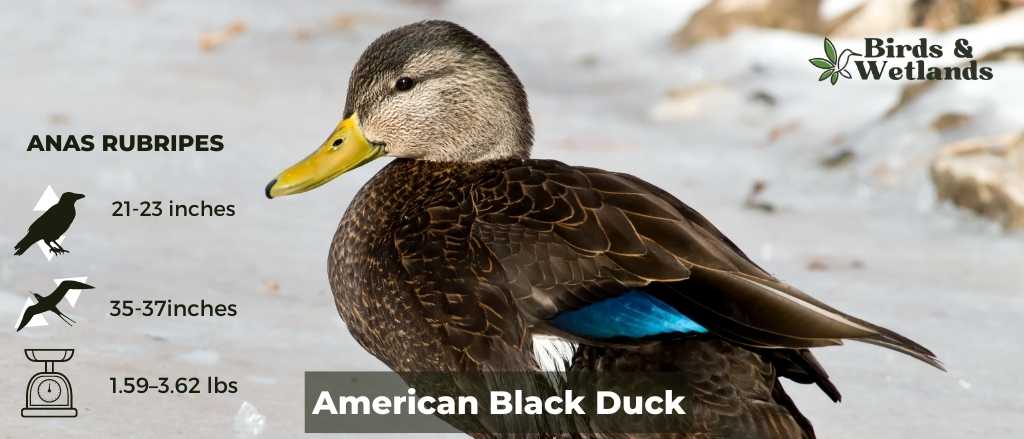
American Black Duck
Listen to American Black Duck
The American black duck belongs to the Anatidae family of big dabbling ducks. American Black Ducks are easily identified by their black plumage and white markings on the face and wingtips.
The males also have an orange bill with a dark tip while females have dark gray bills with white spots on top. Both sexes have dark gray legs and feet which help them blend in with their surroundings.
They are omnivores, but mainly eat aquatic plants such as algae and duckweed. They also eat insects, small fish, snails, and seeds from land plants like clover or grasses which grow near bodies of water where they live.
The habitat for the American Black Duck is ponds and lakes in North America, Europe, Asia, and Australia. They are migratory birds and breed in northern regions like Alaska, Canada, and the northern United States. They have been known to nest on islands or in tree cavities when they cannot find a suitable wetland habitat.
The current population of the American Black Duck is estimated to be around 1 million birds.
Scientific Name: Anas rubripes
Height: 54–59 cm (21–23 in)
Wingspan: 88–95 cm (35–37 in)
Weight: 720–1,640 g (1.59–3.62 lb)
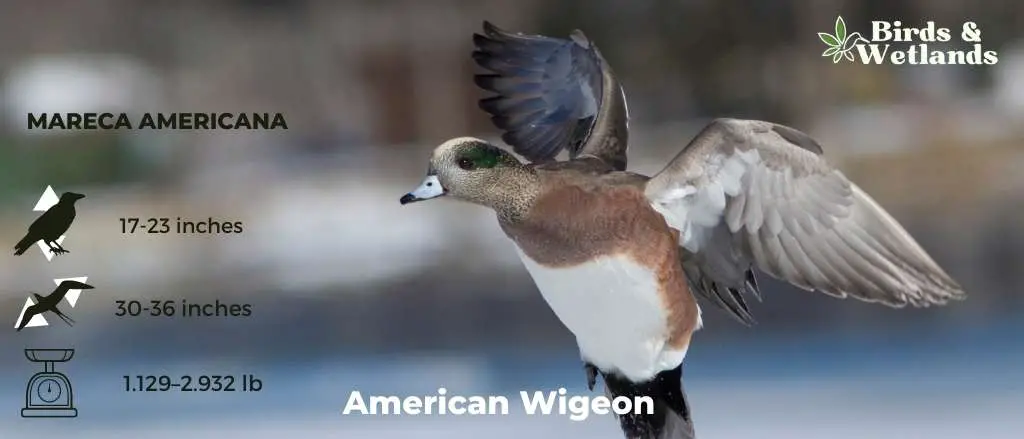
American Wigeon
Listen to American Wigeon
The American Wigeon, also known as the baldpate, is a medium-sized duck that is native to North America, Europe, Asia, and northern Africa.
American Wigeon is known for its bright plumage: males have a blue head and neck with a white breast and belly; females have brown bodies, a brown head with a white eye stripe and yellowish markings on the breast and belly. They also have short legs with two toes on each foot which enable them to walk easily on land or water.
Their diet consists of aquatic vegetation and seeds. They mainly eat aquatic plants, but also take some small invertebrates such as insects or snails from the water’s edge.
This species prefers areas with dense vegetation because they provide an excellent source of food for these birds during the breeding season (i.e., they can feed on aquatic plants). They are usually found in freshwater marshes, ponds, lakes, and river deltas.
They are not migratory and typically remain at the same location year-round. The current population of this bird is estimated at around 2 million individuals worldwide.
Scientific Name: Mareca americana
Height: 42–59 cm (17–23 in)
Wingspan: 76–91 cm (30–36 in)
Weight: 512–1,330 g (1.129–2.932 lb)
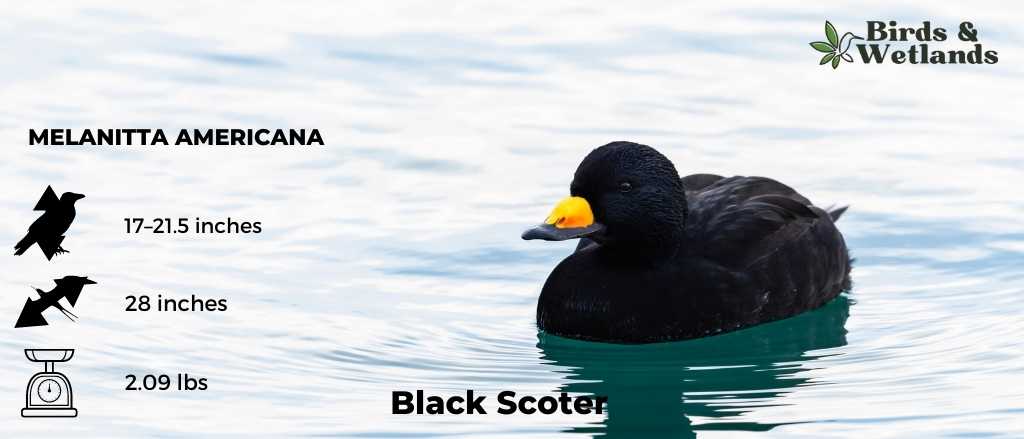
Black Scoter
Listen to Black Scoter
The black scoter, or American scoter, is a large sea duck, that breeds in the far north and winters in fresh water. These birds can be found in North America, Europe, Asia, Greenland, Iceland, and northern Russia.
It is dark brown with a white belly, black breast and neck, and white feathers on its flanks. The male is larger than the female, though both sexes are similar in size. The eye is yellowish-orange with a dark ring around it. The legs are yellow.
They breed in small ponds with deep water, since they prefer to nest in freshwater lakes and rivers rather than saltwater lakes. Their diet consists mainly of fish and crustaceans, aquatic plants including algae, tubers, and seeds, as well as some insects when available.
It is a migratory bird that spends most of its time at sea, but it travels to land on migration routes during spring and fall.
The current population of this species is estimated at 1 million individuals worldwide; however, there are concerns about its future because many of its populations are declining due to habitat loss caused by climate change and pollution.
Scientific Name: Melanitta americana
Length: 430–550 mm (17–21.5 in)
Wingspan: 710 mm (28 in)
Weight: 950 g (2.09 lb)
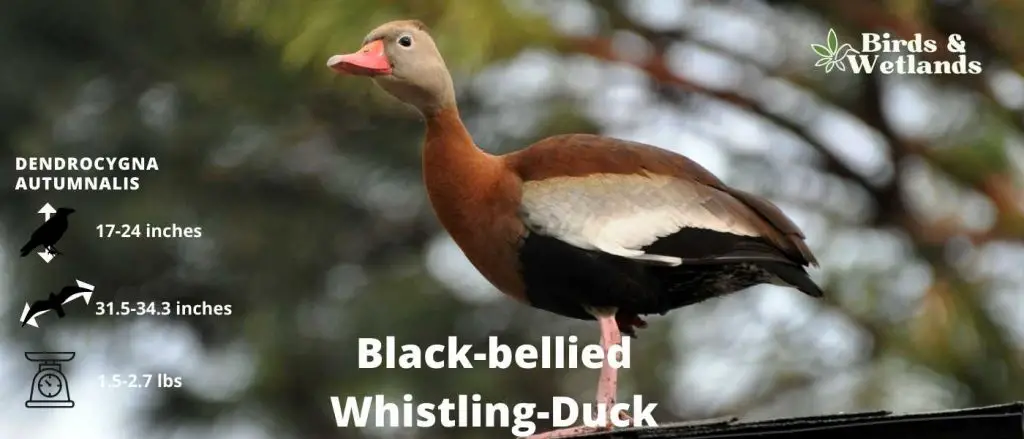
Listen to Black-bellied Whistling-Duck
The Black-bellied Whistling-Duck has an orange bill, brown eyes and brown legs. The male has a white throat and red breast while the female has a brown breast. The male’s bill is longer than the female’s bill but both sexes have long tails.
These ducks can be found in wetland habitats such as lakes and ponds where there are reeds or other tall grasses for them to hide in when threatened by predators like foxes or dogs.
Black-bellied Whistling-Ducks are monogamous, meaning they form lifelong pair bonds with one partner. The male builds a nest out of sticks, and the female lays 5 to 8 eggs in it. The eggs hatch after about 28 days of incubation by both parents.
The main diet of the Black-bellied Whistling-Duck consists of aquatic plants, insects and mollusks. They use their bills to dig up food from mud or soft soil by digging with their feet as well as using their bills to scoop up prey items from shallow water or soft soil.
Scientific Name: Dendrocygna autumnalis
Height: 17-24 inches
Wingspan: 31.5-34.3 inches
Weight: 1.5-2.7 lbs
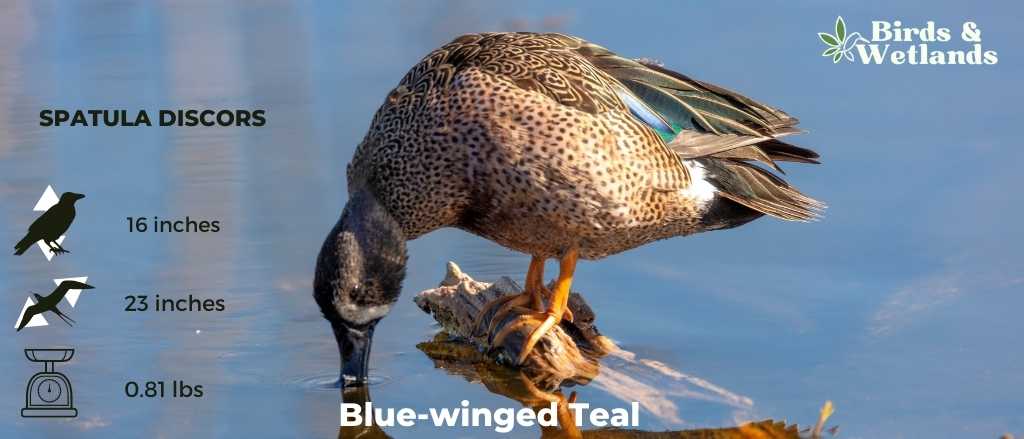
Blue-winged Teals
Listen to Blue-winged Teal
The Blue-winged Teal is a small duck that lives in North America. It has a glossy blue-gray head and back, with a white breast and sides. Its wings are brown with two white stripes, and its tail is also brown with white edges.
The Blue-winged Teal’s diet consists mostly of aquatic plants like pondweed, but it will also eat insects when they are available. This duck often feeds by pecking at the surface of the water rather than diving for food. It will sometimes form small groups to feed together or fly in single file formation when migrating south for winter.
Blue-winged teals are found in marshes, ponds, lakes, and rivers throughout the United States south of Canada, and north of Mexico.
They are migratory birds and fly south for the winter months to warmer climates. It winters along the Atlantic coast from southern New England to Virginia and then moves further south as far as Mexico.
Scientific Name: Spatula discors
Height: 40 cm (16 in)
Wingspan: 58 cm (23 in)
Weight: 370 g (13 oz)

Bufflehead
Listen to Bufflehead
The Bufflehead is one of the most striking ducks in North America. It is a small duck with a pale head, a black breast, and a white belly. It hasa purple to green plumage on the head, white patches on the cheeks and throat, and a distinctive white crescent on each side of its tail. The males also have white chests.
The Bufflehead is a strong flier, but rarely flies more than several hundred yards at a time. It lives on the coast of North America, spending most of its time in salt water.
Buffleheads can eat many different types of foods including clams, crayfish (also known as crawfish), insects such as beetles and flies as well as other small animals such as mice or voles (small rodents). It also feeds on insects and crustaceans found along the bottom of streams or lakes, as well as small fish such as minnows or suckers.
Buffleheads are sea ducks that spend most of their time in freshwater habitats such as lakes, ponds, rivers, estuaries, and bays. They are able to survive in such diverse environments because they are excellent swimmers and divers. Female buffleheads also nest and lay eggs in safely installed nest boxes and tree cavities.
Scientific Name: Bucephala albeola
Length: 32–40 cm (13–16 in)
Wingspan: 21.6 in (55 cm)
Weight: 270–550 g (9.5–19.4 oz)
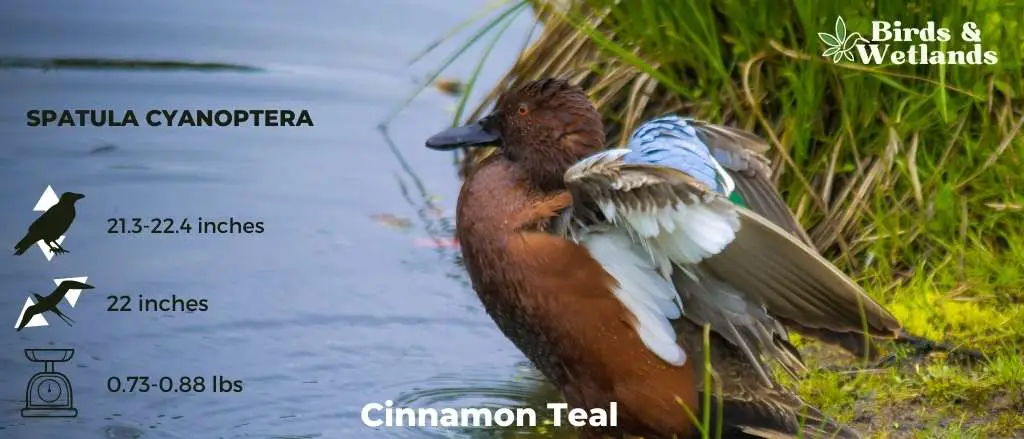
Cinnamon Teal
Listen to Cinnamon Teal
Cinnamon Teal is a small duck with distinctive bright cinnamon-colored feathers on its back and white markings above the eye that is native to North America and Central America.
The diet of this bird includes seeds, insects, and other invertebrates that are found near water sources where they live. Like most ducks, it feeds on aquatic vegetation such as pondweed, watercress, pondweed, and water lilies. This bird has also been known to eat insects and small crustaceans.
They are found in the northern hemisphere and are particularly common in North America, where they breed from Alaska to Canada. They winter south of the U.S., as well as in parts of Mexico and Central America.
The Cinnamon Teal is a very social bird, often living in large flocks during the breeding season and congregating around lakes and rivers during migration. They tend to be shy and elusive, so it can be difficult to see them in their natural habitat.
These birds mate for life and build nests on the ground near water sources—usually shallow ponds or marshes with tall grasses nearby for cover when young are being reared.
Scientific Name: Spatula cyanoptera
Height: 21.3-22.4 in (54-57 cm)
Wingspan: 22-inch (560 mm)
Weight: 11.8-14.1 oz (335-401 g)
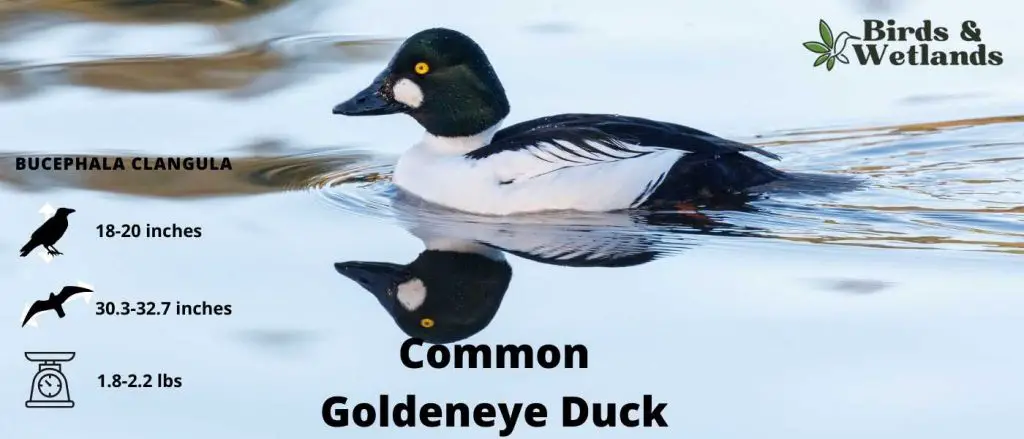
Listen to Common Goldeneye
The Common Goldeneye Duck is a medium-sized diving duck that breeds across the northern hemisphere in North America, Asia, and Europe. It winters in the southern hemisphere.
The male is unmistakable with his black head, white neck and breast, dark grey body and white belly.
Females have mostly grayish bodies and a white neck collar.
During the winter months, they travel south to warmer climates where they can find open water for feeding on fish and crustaceans. The common goldeneye is not considered endangered or threatened by the IUCN red list of endangered species but it does have a special status in several countries due to its popularity as a game bird.
Common goldeneyes are diving ducks that are known for diving underwater to search for food, which makes it difficult for predators such as bears to catch them. They eat aquatic insects, crustaceans like crayfish or shrimp, fish (including salmon), amphibians like frogs or salamanders and other small animals.
Scientific Name: Bucephala clangula
Height: 18-20 inches
Wingspan: 30.3-32.7 inches
Weight: 1.8-2.2 lbs
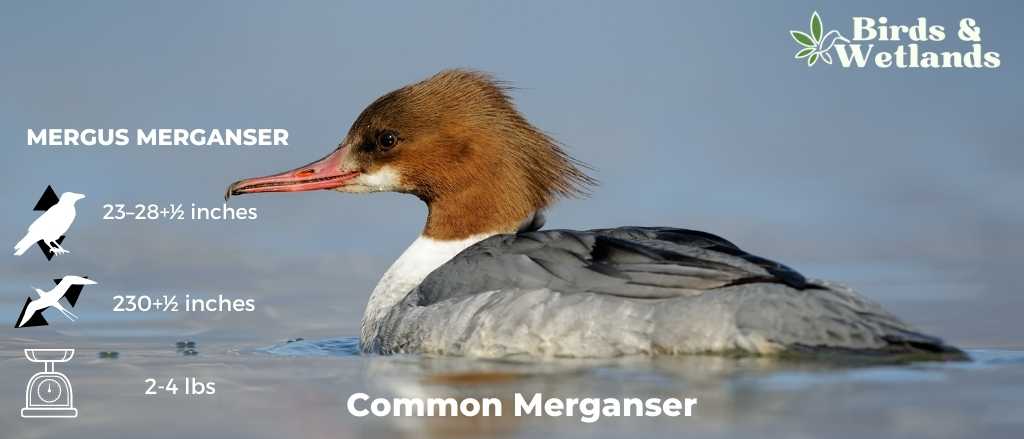
Common Merganser
Listen to Common Merganser
The common merganser, sometimes known as the goosander, is a huge sea duck found in wooded parts of Europe, Asia, and North America. They have a long bill that is pointed at the end and has a black tip on it. Their plumage is mostly dark with a white underside. They have very large feet and webbed toes to help them swim. Their legs are long and slender as well.
Common mergansers are omnivores, eating both plants and animals such as small fish or insects. They eat their prey by diving underwater and spearing it with their long bill before swallowing it whole.
The habitat of this bird is lakes, rivers, ponds, and marshes. They prefer quieter bodies of water with plenty of vegetation along the shores where they can rest during the day before moving on to hunt at night.
The current population of this bird is considered stable due to its ability to thrive even when there are threats present due to its adaptability as well as its wide range across North America.
Scientific Name: Mergus merganser
Length: 58–72 cm (23–28+1⁄2 in)
Wingspan: 78–97 cm (30+1⁄2–38 in)
Weight: 0.9–2.1 kg (2 lb 0 oz – 4 lb 10 oz)
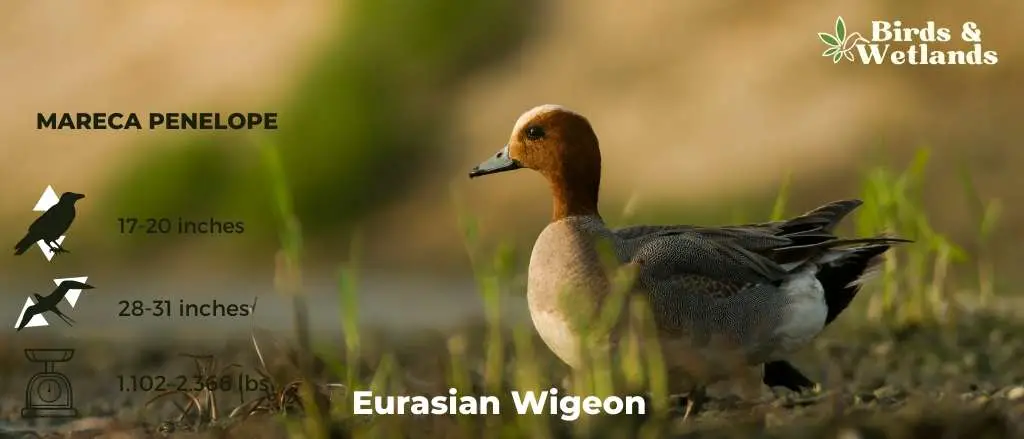
Eurasian Wigeon
Listen to Eurasian Wigeon
The Eurasian Wigeon, or European Wigeon, is a medium-sized duck with a long, pointed bill and a distinctive white crescent on the side of its face. The male Eurasian Wigeon has a light brown body with a dark green head and white cheek stripes on either side of its face. The female Eurasian Wigeon has a lighter brown body with a black head and white cheek stripes on either side of its face.
The diet of Eurasian Wigeon consists of vegetation such as roots, bulbs, tubers, and rhizomes from aquatic plants such as sedges, bulrushes, and other grasses as well as insects such as dragonflies or water boatmen. In wintertime, they feed on aquatic plants like duckweed or reeds in shallow water.
They are found in central and eastern Europe, Scandinavia, Russia, China, Korea, Japan, north-east Siberia and Alaska. They migrate between the breeding grounds in central Asia and southern Europe. They prefer nesting near lakes or ponds but they can also be found nesting on small streams.
The current population of Eurasian Wigeons is estimated at around 1 million birds worldwide with populations declining in many areas due to habitat loss.
Scientific Name: Mareca penelope
Height: 42–52 cm (17–20 in)
Wingspan: 71–80 cm (28–31 in)
Weight: 500–1,073 g (1.102–2.366 lb)
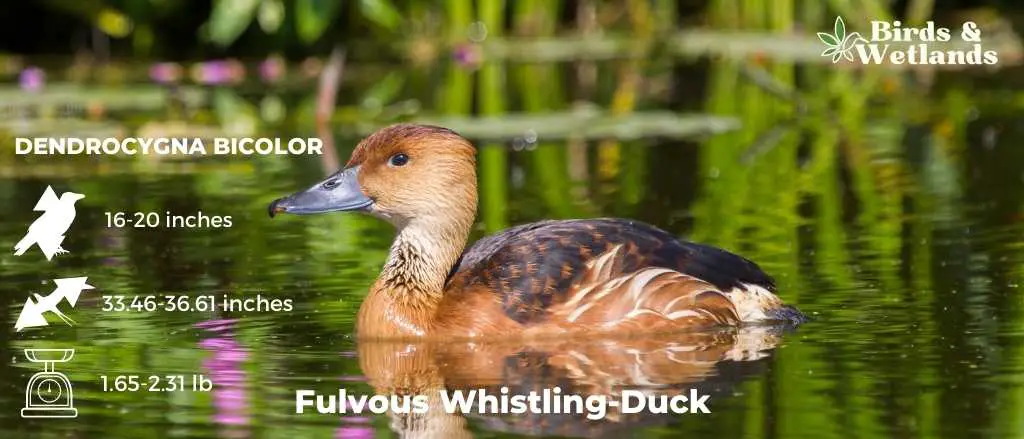
Fulvous Whistling-Duck
Listen to Fulvous Whistling-Duck
The Fulvous Whistling-Duck is a medium-sized duck that is found in Mexico, Central and South America, and the Caribbean. It has a light brown body and a yellow head with a white underside. They have a blackhead, neck, back, and tail. The males are more brightly colored than the females.
The habitat of this bird includes marshes, lakes, and ponds where they feed on seeds, aquatic plants, insects, and occasionally small fish. The Fulvous Whistling-Duck usually nests on the ground near water but may also nest in trees or cattails.
Their diet consists mostly of seeds from grasses or sedges as well as aquatic plants such as pondweeds or duckweed. They also eat invertebrates such as mollusks (snails), crustaceans (crayfish), or insects like dragonflies or beetles depending on what’s available in their habitat at different times of year (e.g., dragonflies during breeding season).
The population of this species has been declining due to habitat loss caused by agriculture and urbanization; however, there are currently no known threats to its continued existence.
Scientific Name: Dendrocygna bicolor
Height: 16 to 20 inches (40 to 50 centimeters)
Wingspan: 85 to 93 cm
Weight: 748–1,050 g (26.4–37.0 oz)
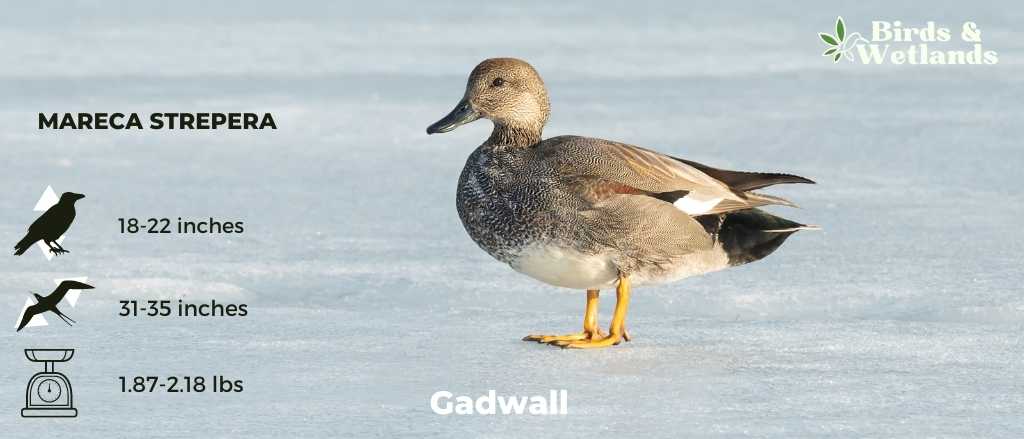
Gadwall
Listen to Gadwall
Gadwall is a duck that’s known for its yellow bill and the white patch on its cheek. It is native to North America, Europe, and Asia. It has a black head and breast, white cheeks, and a buff-colored body. The male’s bill is yellow with a dark tip.
The Gadwall’s color varies depending on its location—in North America, they are a dull brownish-gray, while in Europe their feathers are more of a chestnut brown. Their bills are black with a white tip, and their legs are yellowish-green above black webbed feet.
The only thing that sets them apart from other ducks is their eyes: they have dark brown eyes with a distinctive red circle around them.
Gadwalls are slightly smaller than mallards, with males weighing between 2 and 3 pounds and females weighing between 1.5 and 2 pounds.
Gadwalls eat insects, worms, crustaceans like crayfish, frogs, and tadpoles as well as small fish when available. They will also eat seeds from grasses and plants like watercress
The Gadwall’s habitat is near water; it can be found in marshes, rice paddies, ponds, and lakes.
Gadwalls breed in northern North America and in Europe as far east as Siberia. They also breed in Asia where they are found in Japan, Korea, and China as well as Mongolia and Siberia.
They are migratory birds that fly south in the winter to warmer climates. They migrate south to winter in the southern USA, Mexico, and Central America as well as southern Europe (Spain), Central Africa (Ethiopia), and India. They are usually found in pairs or small flocks during migration and breeding season but tend to be solitary during winter months when they migrate southward.
This species of duck has experienced an increase in population over the last 100 years due to conservation efforts by governments and organizations such as Ducks Unlimited Canada (DUC).
Scientific Name: Mareca strepera
Height: 46–56 cm (18–22 in)
Wingspan: 78–90 cm (31–35 in)
Weight
Male: 990 g (35 oz)
Female: 850 g (30 oz
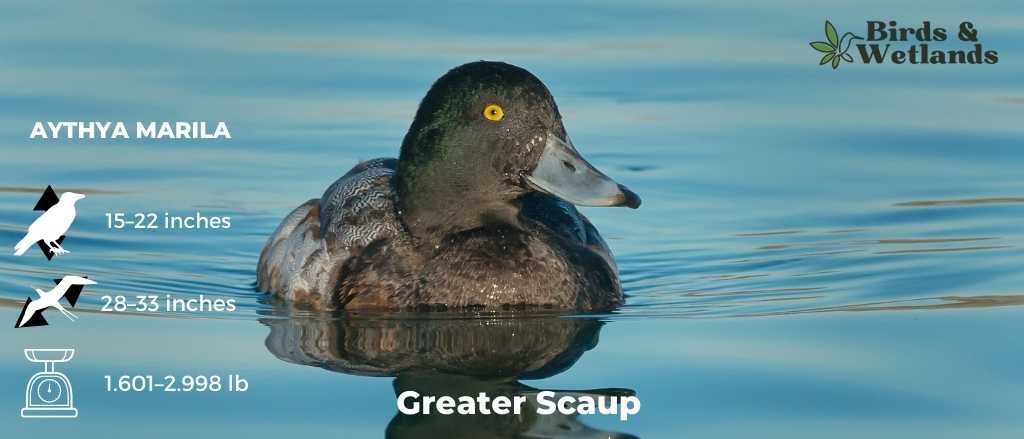
Greater Scaup
Listen to Greater Scaup
The Greater Scaup is a large diving duck with a distinctive white band on its head. The rest of its body is brown with a blue-grey sheen on its back and tail (which can be seen when they fly). The male is larger than the female, with large blue-grey bills and more white wing feathers. It has a black bill, black feet and legs, and gray plumage.
These medium-sized ducks prefer shallow water close to shore where they can feed on aquatic vegetation and small fish. They are omnivorous creatures who feed on mollusks, crustaceans, insects (especially water beetles), worms, and other small invertebrates like larval dragonflies which comprise about 60% of their diet.
This species breeds in the northern taiga regions of Canada and Alaska and winters in the Atlantic and Pacific Oceans, as well as some inland lakes. It is an uncommon sight in North America but can be found in many areas across Europe, Asia, Africa, and Australia. In winter, it migrates to southern Canada and parts of the northeastern United States.
Scientific Name: Aythya marila
Height: 39–56 cm (15–22 in)
Wingspan: 71–84 cm (28–33 in)
Weight: 726–1,360 g (1.601–2.998 lb)
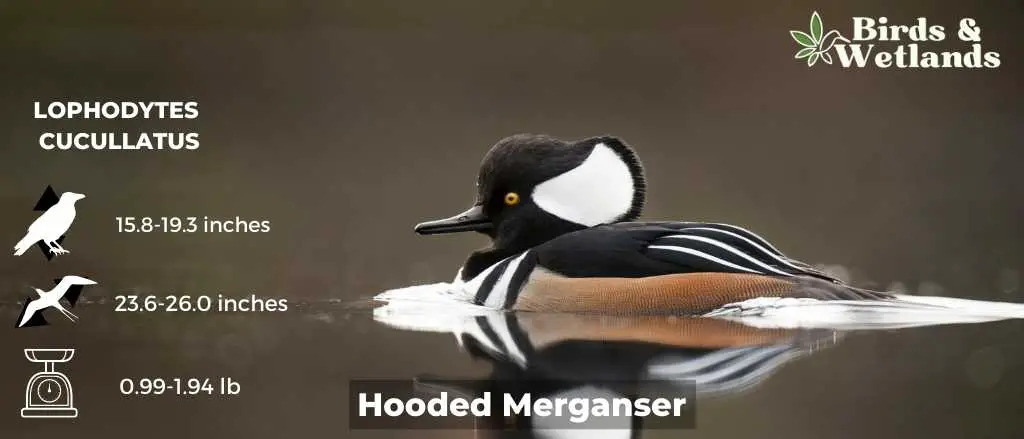
Hooded Mergansers
Listen to Hooded Mergansers
The hooded merganser, also known as the hooded duck, is a species of duck that lives in North America. It has a black head and a brown back. The male has yellow eyes while the female has dark eyes.
The Hooded Mergansers are a relatively small duck with a slender body and a long tail. It has a white breast and belly, as well as a black cap and crest, which creates the illusion of the bird wearing a hood.
Hooded Mergansers eat mostly fish—they dive underwater to catch them! They also eat crayfish, crustaceans such as shrimp or krill, frogs, snails, and insects such as dragonflies or grasshoppers when they are unable to find enough food near the surface of water bodies.
The Hooded Merganser lives in North America and spends most of its time in freshwater ponds, lakes, and rivers during the spring breeding season. It moves to saltwater marshes during the winter months to avoid freezing temperatures.
The Hooded Merganser is currently listed as Least Concern by the IUCN Red List because its population is stable or increasing and it has a large range.
Scientific Name: Lophodytes cucullatus
Length: 15.8-19.3 in (40-49 cm)
Wingspan: 23.6-26.0 in (60-66 cm)
Weight: 16.0-31.0 oz (453-879 g)
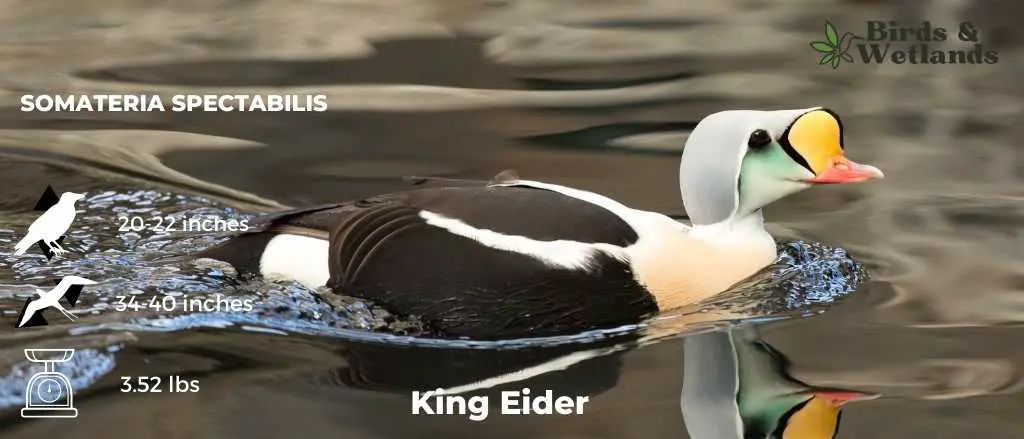
King Eider
Listen to King Eider
The King Eider is a large sea duck that breeds in Arctic and sub-Arctic regions from Alaska to Greenland and along most of the northern Hudson Bay shoreline.
It is so named because of its magnificent crest, which it can raise or lower at will. It has a stocky body, a large head, and a short neck. Its plumage is brownish-gray on the back and sides, with a white belly and chest.
The King Eider prefers breeding grounds near the sea, where they can feed on mussels and other shellfish. They also eat small fish and crustaceans.
This species is found in coastal areas near water during the summer months, but it will migrate during winter months to coastal areas away from ice sheets where it can find food. They typically live about 15 years in the wild but have been known to live up to 35 years in captivity.
This bird can dive to depths of about 30 meters for over 30 seconds at a time in search of food such as small fish or mollusks.
The king eider is listed as Vulnerable by Birdlife International because its population has declined by more than 10% since 1980 due to overhunting in some parts of its range.
Scientific Name: Somateria spectabilis
Height: 52–57 cm (20–22 inches)
Wingspan: 86–102 cm (34–40 in)
Weight: 1.6 kg
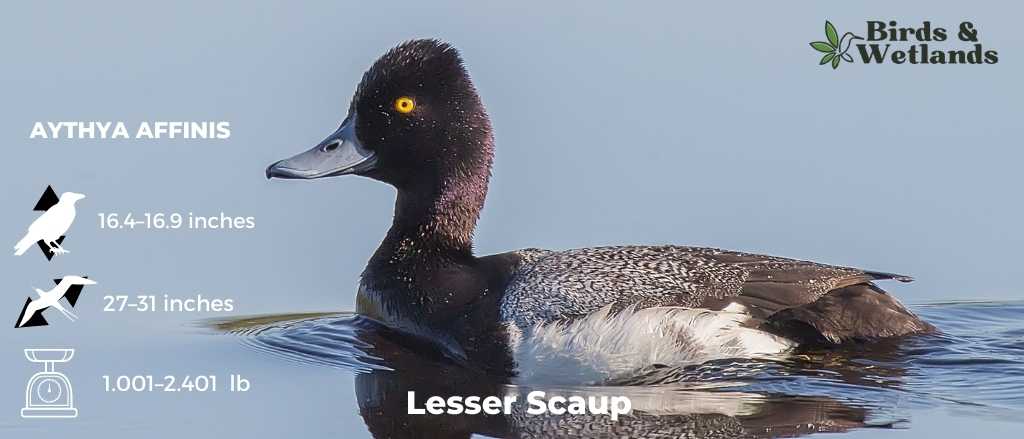
Lesser Scaup
Listen to Lesser Scaup
The lesser scaup is a tiny diving duck native to North America that winters in Central America. It is a smaller version of the Greater Scaup, and it can be distinguished from that species by its black breast, which contrasts with the white breast of the Greater Scaup.
They are one of the most abundant waterfowl in North America and are found across Canada and the United States. Because of its unusual blue bill, it is also called the small bluebill or broadbill.
The Lesser Scaup’s habitat is typically freshwater lakes, rivers, and streams. They can also be found on large ponds and reservoirs with plenty of aquatic vegetation.
Lesser Scaups eat mostly fish but also insects and small crustaceans, which they find by diving beneath the surface of the water for up to 40 seconds at a time. They are very territorial birds, so you may see several males fighting over territory during the breeding season.
Lesser scaups breed in ponds and lakes across Canada and much of the northern United States from late April through May. They usually nest in colonies with other species such as mallards or common goldeneyes.
The Lesser Scaup is not considered to be endangered or threatened and is currently listed as Least Concern by the International Union for Conservation of Nature (IUCN).
Scientific Name: Aythya affinis
Height: 41.7–43 cm (16.4–16.9 in)
Wingspan: 68–78 cm (27–31 in)
Weight: 454–1,089 g (1.001–2.401 lb)
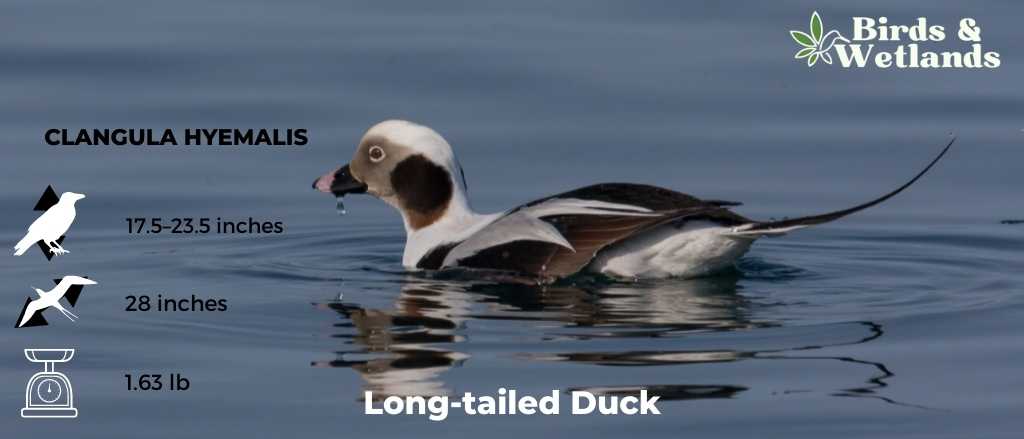
Long-tailed Duck
Listen to Long-tailed Duck
Long-tailed Ducks are species of duck that are native to Australia and New Zealand. They are named for their long, narrow tail, which can be over 30% longer than the rest of their body. It has a black bill, brown eyes, and grayish-brown feathers on its back and wings. The underside of the bird is white in color.
The Long-tailed Duck eats aquatic plants, seeds, insects, snails, mollusks, crustaceans, fish eggs, and small fish. They can dive up to 60 feet below the surface.
These species of duck prefer to live in areas where there are plenty of lakes and ponds for them to feed on. They are also known for being very territorial so they tend not to share their space with other species unless they have no choice but to or if they’re trying to breed.
They are migratory birds, traveling from Canada to Europe during the summer months before returning south for winter months in North America or Asia.
They can be found in Europe, Asia, North America, and parts of South America. They breed in freshwater lakes from May through July or August depending on where they live. They migrate to southern latitudes during the winter months to avoid freezing temperatures.
Long-tailed Ducks have a current population of roughly 2 million individuals worldwide—that’s down from an estimated 4 million during the 1980s.
Scientific Name: Clangula hyemalis
Length: 440–600 mm (17.5–23.5 in)
Wingspan: 710 mm (28 in)
Weight: 740 g (1.63 lb)

Mallard
Listen to Mallard
The Mallard is a small, wild duck that lives in the United States and Canada. It’s a duck that is native to the Northern Hemisphere. It has a beautiful green head and a brown body, and it’s known for its long, lobed tail.
They have black bills and yellow feet, which makes them easy to identify. Males have purple patches on their wings and a white-tipped tail. The female mallard is mottled brown with a brown bill.
Their diet consists mostly of seeds, fruit, and insects. Mallards have been known to consume small rodents if they are available. They also eat frogs and fish when they can catch them. They usually feed at night in shallow water or on land near water sources.
Their habitat is primarily in wetlands such as ponds, lakes, and rivers. They also inhabit saltwater environments close to lands such as bays and estuaries.
They are also very social birds that travel in flocks during the breeding season and pair off into monogamous pairs during the winter months when they migrate southward to warmer climates where food sources are more plentiful.
Scientific Name: Anas platyrhynchos
Height: 50–65 cm (20–26 in)
Wingspan: 81–98 cm (32–39 in)
Weight: 0.7–1.6 kg (1.5–3.5 lb)

Masked Duck
Listen to Masked Duck
The Masked Duck is a medium-sized water bird, with a slender neck and long legs. It is a species of waterfowl that live in the United States, Mexico, and Central America.
It has a blackish bill, black hood, and grey body. It’s one of the most distinctive birds in the world because of its bright red face mask, white cheeks, and black “mask” around its eyes. The male and female have identical plumage, although the males are generally slightly larger.
Masked ducks are omnivores that eat plants and animals; they feed by dabbling for plant material or hunting insects, worms, crustaceans, and mollusks above water or underwater by up to 7 feet (2 m) deep.
The masked duck is found in freshwater wetlands of eastern North America from the Atlantic coast west to Minnesota, south to Florida, and Texas; also found in Mexico. They are generally not migratory but may wander further south during winter.
The masked duck is not endangered but it is considered to be vulnerable due to habitat loss due to human development.
Scientific Name: Nomonyx dominicus
Length: 12- 14 inches
Wingspan: 17 in (43 cm)
Weight: 9.7-15.8 oz (275-450 g)
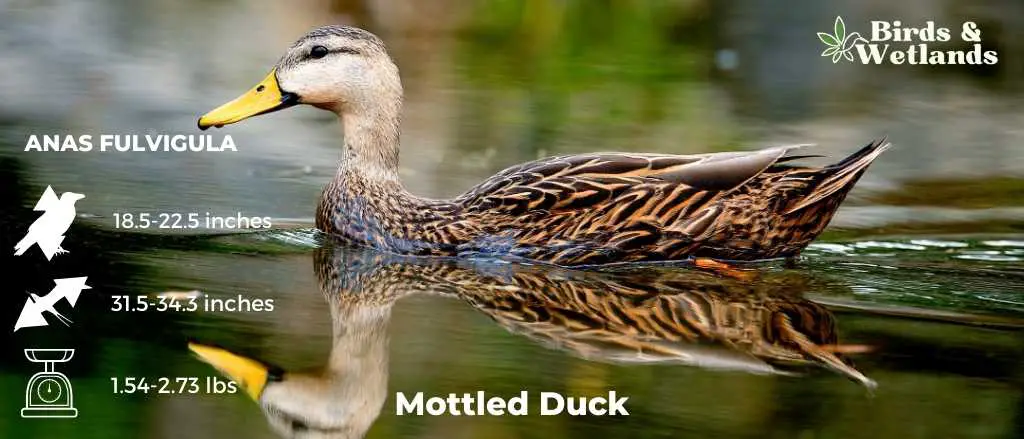
Mottled Ducks
Listen to Mottled Duck
The Mottled Duck is a medium-sized diving duck with an olive-brown head and body, black spots on its white breast and flanks, and a pale blue bill.
Mottled Ducks have a bright orange bill, with a black head and neck, white cheeks, black back, and tail feathers. They also have some white breast feathers. The males are more colorful than the females. Males have a gray chestnut head and neck with black back feathers. Females have a white chestnut head and neck with black back feathers as well as a black bill with an orange-yellow tip..
Their diet is made up of aquatic insects, mollusks, crustaceans, and aquatic plants such as pondweeds, duckweeds, and bladderworts. It also includes insects like dragonflies and beetles as well as small fish like minnows or other small amphibians like frogs or salamanders.
It is found in freshwater lakes and ponds in southern Canada, the eastern United States, Mexico, Central America, Europe, Asia and Africa, and northern South America.
Mottled Ducks are monogamous birds; they mate for life and nest in tree holes or on the ground near water bodies where they can easily find food for their younglings.
Scientific Name: Anas fulvigula
Height:
Male: 19.7–22.5 in (50–57 cm)
Female: 18.5–21.0 in (47–53 cm)
Wingspan:
Male: 32.7–34.3 in (83–87 cm)
Female: 31.5–327.2 in (80–831 cm)
Weight:
Male: 30.9–43.8 oz (880–1,240 g)
Female:24.7–40.6 oz (700–1,150 g)
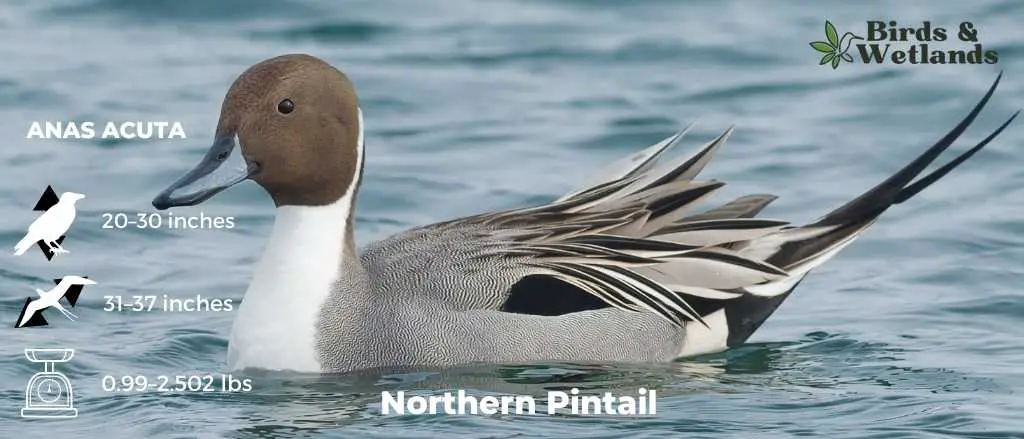
Northern Pintail
Listen to Northern Pintail
The Northern Pintail is an uncommon duck that can be found in North America and Europe. This duck is a medium-sized, strong-flying waterfowl with a long neck and tail and a pale gray body.
Both sexes have grey legs and feet and a pale black-gray bill. But the males have gray bodies while females have brown plumage. A faint white stripe runs from the rear of the drake’s chocolate-colored head down its neck to its mainly white undercarriage, making it more noticeable.
The drake’s back and flanks have excellent grey, brown, and black patterning. The hen’s plumage is more muted, with dull brown feathers that resemble those of other female dabbling ducks. The drakes emit a flute-like whistle, while the hens make a harsh quack.
The Northern Pintail is a migratory bird that nests on or near open water with some vegetation nearby. This bird feeds on aquatic plants such as bulrush roots, pondweeds, and sedges; seeds from different plants like grass; insects such as dragonflies; fish; other small animals such as mice or frogs; and worms, which are their favorite food source for survival (when they’re not eating seeds).
There are approximately 1 million Northern Pintails left in the wild today.
Scientific Name: Anas acuta
Height:
Male: 59–76 cm (23–30 in)
Female: 51–64 cm (20–25 in)
Wingspan: 80–95 cm (31–37 in)
Weight:
Male: 450–1,360 g (0.99–3.00 lb)
Female: 454–1,135 g (1.001–2.502 lb)
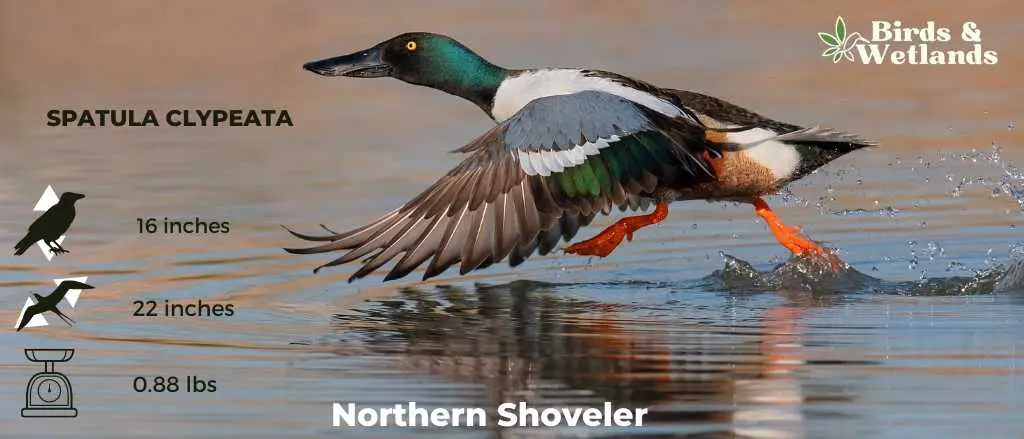
Northern Shoveler
Listen to Northern Shoveler
The northern shoveler, often known as the shoveler in the United Kingdom, is a common and ubiquitous duck. With its brown head and neck and breast, greenish-yellow bill and wings, white breast and belly, dark greenback, and black tail feathers, it’s hard to mistake for any other duck species. The males have green heads.
This duck lives in freshwater ponds, marshes, lakes, rivers, and streams but will also sometimes inhabit brackish water areas where the water has a high salt content. It breeds in North America from Canada to Mexico, migrating south for the winter months.
The Northern Shoveler’s diet consists primarily of aquatic plants like duckweed and water lettuce. It also eats insects, worms, crustaceans, and mollusks if they can find them in the water.
Wintering in southern Europe, the Indian subcontinent, Southeast Asia, Central, the Caribbean, and northern South America, it breeds in northern Europe, through the Palearctic, and across much of North America.
Scientific Name: Spatula clypeata
Height: 16 in (41 cm)
Wingspan: 22-inch (560 mm)
Weight: 14 oz (400 g)
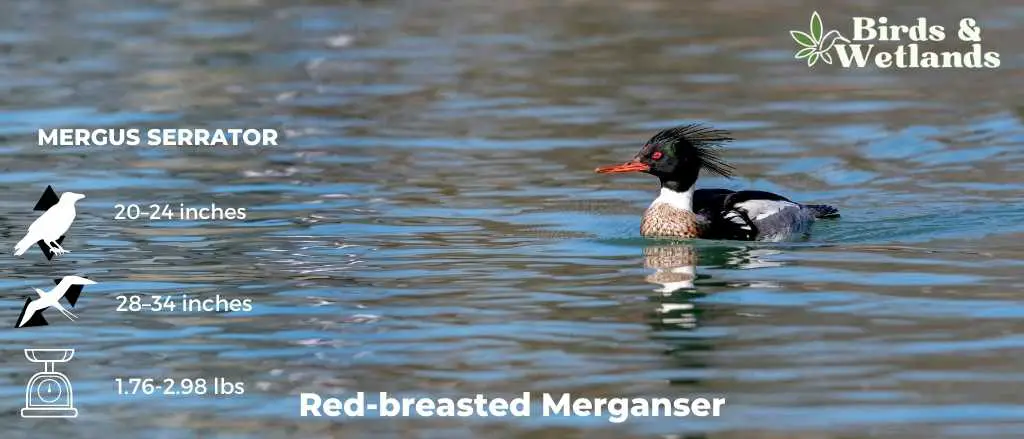
Red-breasted Merganser
Listen to Red-breasted Merganser
The Red-breasted Merganser has an appearance that makes it easy to identify. The feathers on their chest are red in coloration, and they have a white throat area. They are known for their bright red chests, which is what gives them their name.
This bird has a long body with a white underside and black head, neck, back, and tail. Its wings are brownish-grey and its bill is yellow with an orange tip.
They feed on fish by diving into the water using their wings to propel themselves forward like penguins do when swimming underwater. They also eat amphibians such as frogs or newts if they can catch them.
The habitat of this bird includes lakes, rivers, and ponds where they can dive into the water to catch fish while swimming underwater or dive from above the water to catch fish resting on the bottom of lakes or ponds. Red-breasted mergansers breed in boreal forests.
This bird is not endangered or threatened at this time because it has a very large population of over 8 million birds worldwide.
Scientific Name: Mergus serrator
Length: 51–62 cm (20–24 in)
Wingspan: 70–86 cm (28–34 in)
Weight: 28.2 to 47.6 oz (800 to 1,350 g)
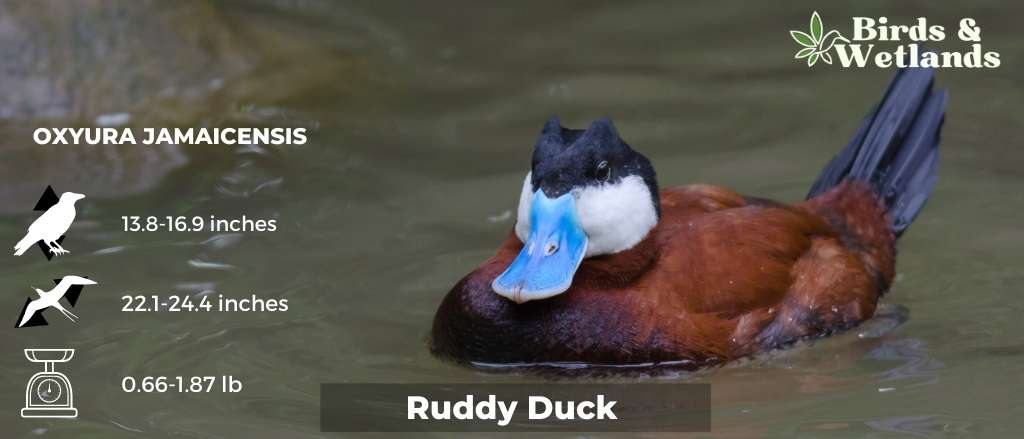
Ruddy Duck
Listen to Ruddy Duck
Ruddy Duck is a medium-sized diving duck that’s native to North America. They’re known for their ruddy, or reddish-brown coloration, which is most prominent during the breeding season. It has a white breast and white stripe on its face. Breeding males have bright blue bills.
Ruddy Ducks are omnivorous, eating plants and insects as well as fish and small animals. It eats insects, grains, seeds, and aquatic plants. They are monogamous animals; they mate for life and have one clutch per year of 4-6 eggs that hatch after 25 days.
Ruddy Ducks frequently move in small groups of 5–15 birds at night. They’re also very sociable animals.
Ruddy Ducks live in freshwater lakes, ponds, rivers, marshes, and swamps. They are migratory birds that spend the winter in South America.
Ruddy Ducks breed near freshwater lakes and marshes during the breeding season (April through August), but they can also be seen on rivers or coasts during migration or wintering months (October through February).
Scientific Name: Oxyura jamaicensis
Length: 13.8-16.9 in (35-43 cm)
Wingspan: 22.1-24.4 in (56-62 cm)
Weight: 10.6-30.0 oz (300-850 g)
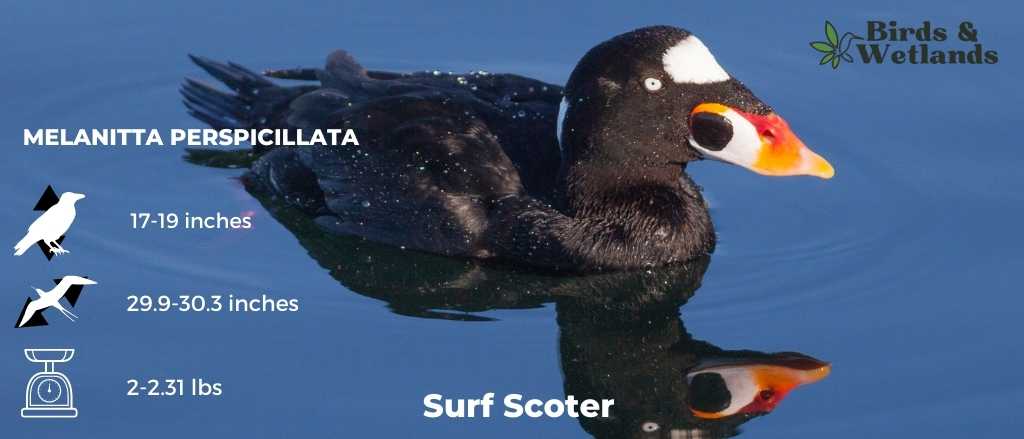
Surf Scoter
Listen to Surf Scoter
The Surf Scoter is a medium-sized sea duck black head, a colorful bill and white patches on the nape and forehead. They are “molt migrants,” meaning they migrate to an area where they may molt their flying feathers after nesting.
The Surf Scoter is an excellent swimmer, with webbed feet that allow it to dive after fish. They are able to dive deep into the ocean to find food, but they can only stay underwater for about 1 minute before having to come up for air.
The Surf Scoter’s diet consists of fish such as sand eels, anchovies, capelin, smelt, and herring. At times they can also feed on crustaceans such as krill or shrimp. It uses its bill to filter out small organisms from the water as it swims along the surface of the ocean.
The Surf Scoter breeds on Arctic coasts from Greenland to Alaska, but most populations migrate south to winter off California and Mexico. They can also be found along the coastlines of South America, Australia, New Zealand, and Japan.
Scientific Name: Melanitta perspicillata
Length:
Male: 48 cm (19 in)
Female: 44 cm (17 in)
Wingspan: 29.9-30.3 in (76-77 cm)
Weight:
Male: 1,050 g (2.31 lb)
Female: 900 g (2.0 lb)
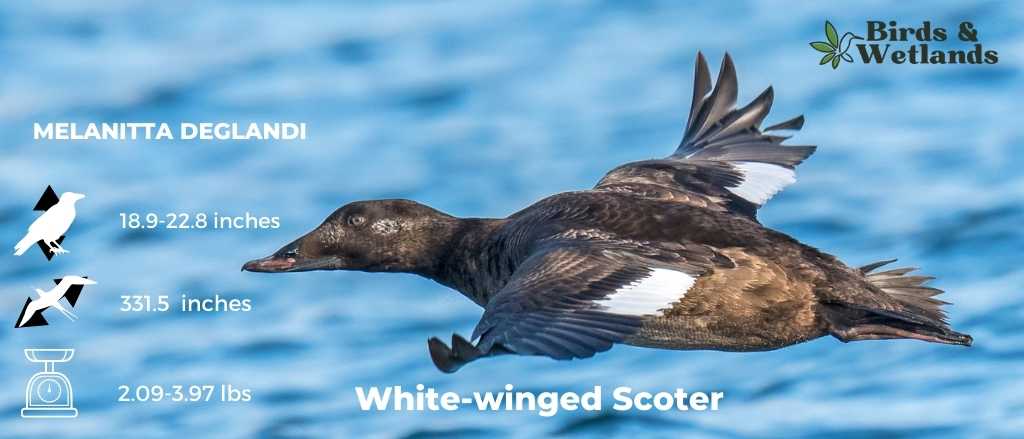
White-winged Scoter
Listen to White-winged Scoter
The White-winged Scoter is classified as an “oceanic” bird because it spends most of its time in marine waters. They have white feathers on their wings and are named after the white patch on their back. It is a medium-sized duck that has a black head, neck, and upper body, with a white breast and belly. The rest of its plumage is dark brown. Females have distinct white patches on their faces.
They feed primarily on mollusks, crustaceans, and fish, which they find by sweeping their bills side to side through the water in search of prey. When this happens, you’ll hear them make a loud clacking noise with their bills—which is how they got their name “scoter”.
It prefers to make its home near the coastlines of North America, Europe, and Asia. They can be found in large groups of other waterfowl but prefer to keep themselves separate from them.
They are migratory birds that make seasonal journeys between northern Canada and Mexico each spring/summer season before returning south for the winter months (December through April).
Scientific Name: Melanitta deglandi
Length: 18.9-22.8 in (48-58 cm)
Wingspan: 31.5 in (80 cm).
Weight: 33.5-63.5 oz (950-1800 g)
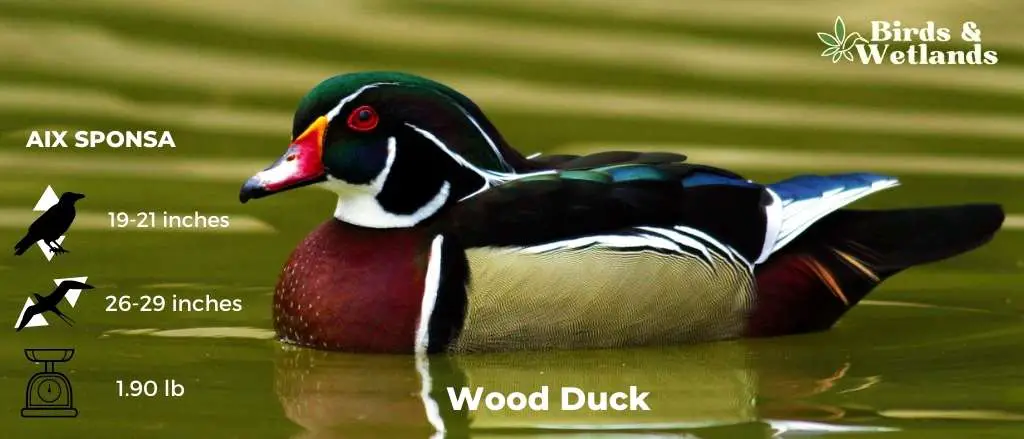
Wood Ducks
Listen to Wood Ducks
The Wood Duck is a medium-sized duck that has a long body, a short neck, and a large head. It has black plumage with white patches on its wings and tail, as well as its bill. It also has a bright red patch of skin at the base of its bill.
The male wood duck is an amazingly colorful bird. With its bright green head and dark reddish-brown chest, it’s not hard to see why this duck is so popular. The female has a blue patch on the wings.
Wood Ducks (Aix sponsa) are a member of the Anatidae family and is native to North America. It ranges from southern Canada all the way down to Panama.
They are omnivores meaning they eat both plants such as cherries and grapes, aquatic plants such as pondweeds and water lilies, and animals but are mainly insectivores feeding on small invertebrates such as insects and worms.
They live in wooded areas near water sources like ponds, lakes, rivers, streams, marshes, and swamps. They live in large flocks during the breeding season and then move to smaller groups during migration or winter.
The population of the wood duck was in serious decline in the late 19th century as a result of severe habitat loss and market hunting both for meat and plumage for the ladies’ hat market in Europe. By the beginning of the 20th century, wood ducks had virtually disappeared from much of their former range.
Scientific Name: Aix sponsa
Height: 47 to 54 cm (19 to 21 in) ( or 1.5 feet max.)
Wingspan: 66 to 73 cm (26 to 29 in)
Weight: 454-862 g (16.0-30.4 oz)
Canvasback (Aythya valisineria)
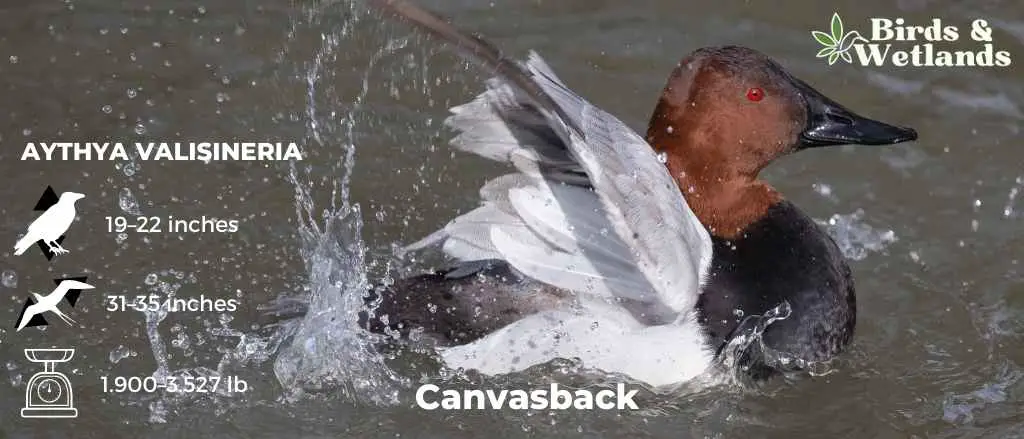
Canvasback
Canvasbacks are large diving ducks that have reddish-brown heads and neck and a white body and are found all over the Northern Hemisphere.
Scientific Name: Aythya valisineria
Height: 48–56 cm (19–22 in)
Wingspan: 79–89 cm (31–35 in)
Weight: 862–1,600 g (1.900–3.527 lb)
Canvasback Description
The Canvasback makes a royal appearance. The male’s white back and flanks reminded English settlers of canvas fabric, hence the name. With a red-brown head and flashing crimson eyes, the drake (male) is a striking appearance.
It is a medium-sized duck that is easily recognizable by its distinct head pattern. Its bill is mostly orange with a black tip, and it has a dark brown head and neck. Its body is primarily white with black speckles on the wings, back, and sides.
Canvasback Sound
Canvasback Habitat & Range
The habitat of the canvasback includes lakes and ponds in North America, Europe, Asia, and Australia. Canvasbacks breed in North America’s Prairie Pothole Region. They like to build their nests above water in permanent Prairie wetlands with emergent plants such as cattails and bulrushes for protection.

Canvasback
Canvasback Diet
The canvasback is a versatile feeder that can consume plants ranging in size from tiny strands to large leafy growths. It has been seen feeding upon countless species of aquatic vegetation, including pond weeds and wild celery as well! The bird also takes interest in snails or other mollusks for food sources not related directly with waterfowl production- think gastropods (slugs & snail shells) insects , small fish – which it may catch while hunting its own kind underwater among foliage near shallow coastal waters where these animals breed.
Canvasback Nesting
They nest in tree cavities and will lay anywhere from 8-15 eggs. The female incubates the eggs for 28-30 days while the male sits on them to keep them warm. When they hatch they are able to swim immediately!
Green-winged Teal (Anas crecca)
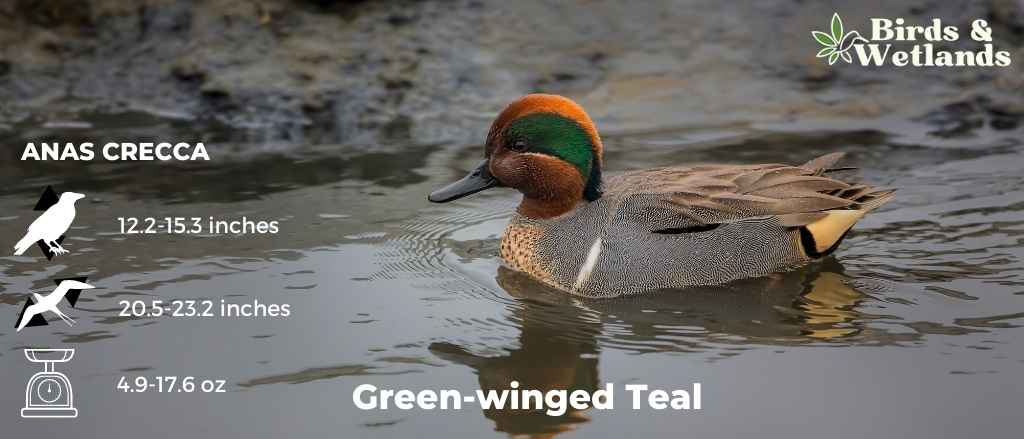
Green-winged Teals
Green-winged teals breed across northern North America. They are also known as “green wings” or “bluebills”. For a long time, it was believed conspecific with the Eurasian teal, but it has subsequently been classified as a separate species. They are the second most hunted duck in the state.
Scientific Name: Anas crecca
Height: 12.2-15.3 in (31-39 cm)
Wingspan: 20.5-23.2 in (52-59 cm)
Weight: 4.9-17.6 oz (140-500 g)
Description
It has an olive-brown back, a white breast, and a brown head with a white stripe above the eye. The male has a green speculum (the outer web of feathers on the wings) that extends from his shoulders to his tail. It also has a vertical white stripes on each side of the wings. They also have chestnut-brown heads. The female’s speculum is more subdued than that of the male; it appears as a pale buff color, not greenish like the male’s. Also, the female has a mottled brown body. Both sexes have a green patch on the wings.
Sound
Habitat & Range
This duck has been introduced into many parts of Europe and Asia where it has become an invasive species due to its ability to adapt to new environments quickly. As a result, it is now considered one of the world’s most invasive birds according to BirdLife International’s Global Invasive Species Database (GISD).
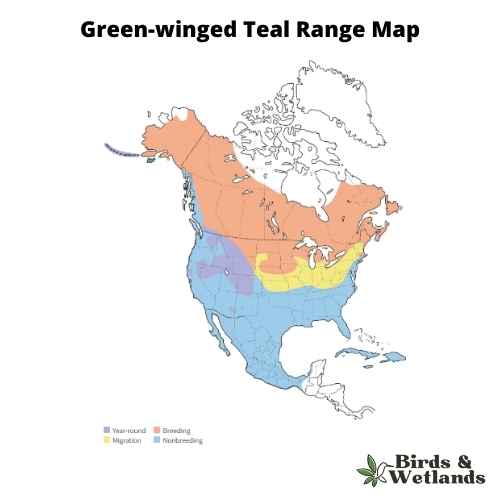
Green-winged Teal
Green-winged Teal Diet
In the winter months, they eat seeds, grains, and insects but during the summer months they switch over to eating aquatic plants like pondweeds, watercress, and duckweed which make up about 70% of their diet.
Green-winged Teal Nesting
The Green-winged teal nests on the ground near water sources such as streams or ponds. The female lays between 7-15 eggs per clutch (which means cluster) which incubate for 25 days before hatching out into ducklings!
Redhead (Aythya americana)
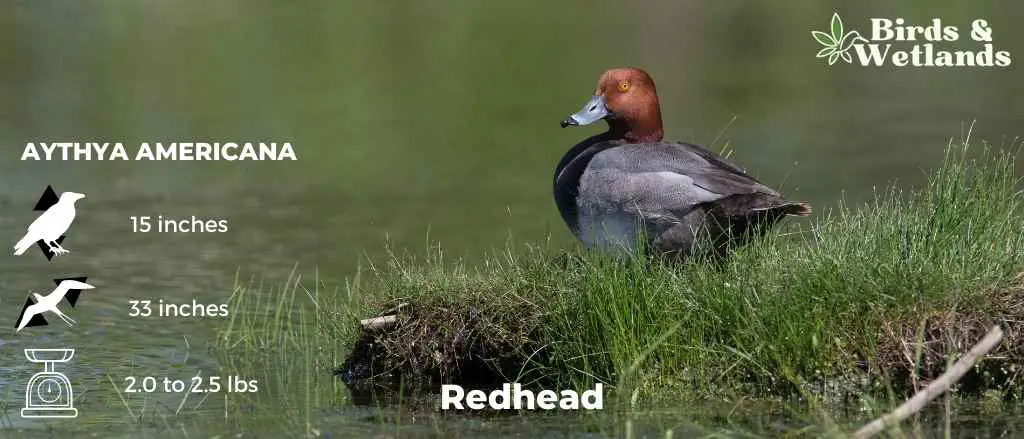
Redhead
The redhead duck is one of the most striking birds in North America. They are easily recognizable by their bright orange-red heads and chests, which contrast sharply with their pale grey bodies. Redheads are also known for their distinctive call, which sounds like a high-pitched whistle.
Scientific Name: Aythya americana
Length: 37 cm (15 in)
Wingspan: 84 cm (33 in)
Weight: 2.0 to 2.5 lbs
Redhead Description
Redhead Ducks are a common sight at the pond. They have a red head and white body, with some gray feathers on their wings. They are about the size of a mallard duck, but have shorter legs and a longer bill. The male has a black chest.
Redhead Sound
Redhead Habitat & Range
Redheads can be found throughout North America, with the exception of southern Mexico and parts of the southeastern United States. They are most common in coastal areas and large rivers. In fact, many people mistake them for musk ducks when they see them in freshwater habitats. Redheads tend to prefer shallow waters with plenty of vegetation near shorelines or riverbanks instead of deeper water where musk ducks tend to prefer staying put.
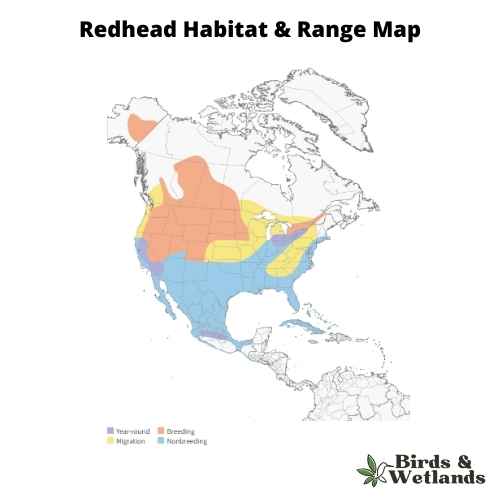
Redhead Range Map credit: https://www.allaboutbirds.org/
Redhead Diet
The redhead diet mainly consists of plant matter such as seeds, berries, shoots and buds from aquatic plants such as pondweed or cattails as well as insects such as dragonflies or small fish like minnows or smelt.
Redhead Nesting
The Redhead Duck lives on a diet of seeds and aquatic plants as well as insects and small fish. The female Redhead Duck lays between 8-12 eggs per clutch, which she then incubates for 28 days before they hatch. The male Redhead Duck will stay nearby while she is incubating her eggs and will care for them once they hatch by leading them to water where they can find food to eat.
Ring-necked Duck (Aythya collaris)
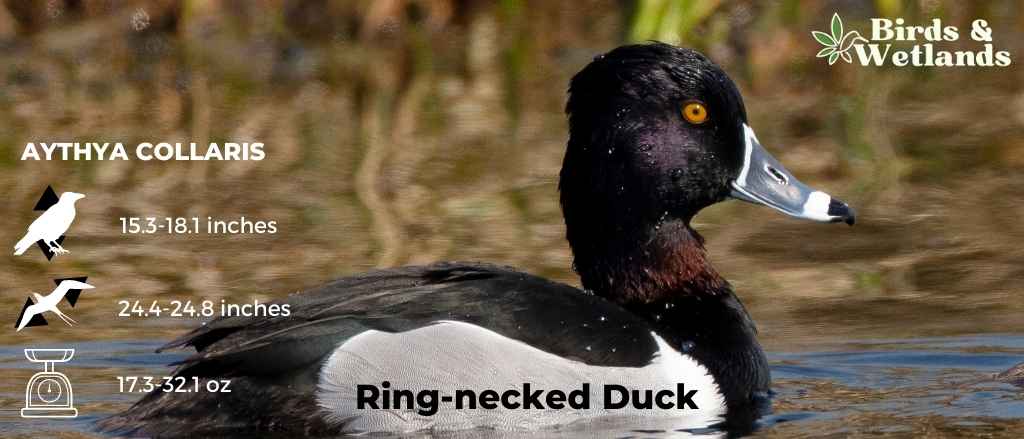
It has a bright orange bill with a black tip and an olive-green head with a black mask across its eyes and down its beak. Its neck is white and speckled with gray, brown, or black patches. The rest of its body is grayish-brown to dark brown.
Scientific Name: Aythya collaris
Height: 15.3-18.1 in (39-46 cm)
Wingspan: 24.4-24.8 in (62-63 cm)
Weight: 17.3-32.1 oz (490-910 g)
Description
They are omnivorous so they also eat seeds and grains when they’re available too. They eat grasses, insects such as beetles and dragonflies when they’re available, seeds, and other types of plants like duckweed, water lilies, pondweeds, and grasses that grow along water edges or in open water areas.
Sound
Habitat & Range
It can be found throughout North America, Central America, and northern South America. It breeds in freshwater marshes, ponds, lakes, and streams. They’re also known to breed in saltwater marshes.
They use their bills to eat these things from the bottom of the lake or pond. They also swim underwater when they eat food. It prefers freshwater marshes, lakes, ponds, streams, rivers, and estuaries near forest edges where trees provide nesting sites for the ducklings.
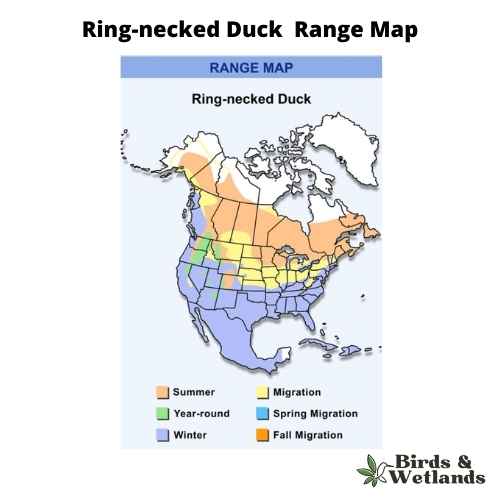
Ring-necked Duck Range Map credit: https://perceviaassets.azurewebsites.net/
Ring-necked Duck Diet
They feed on aquatic plants like pondweed as well as insects and other invertebrates. They will also eat small crustaceans such as crabs or shrimp if they can find them in their habitat.
Ring-necked Duck Nesting
During breeding season (which is usually in April or May), males will form flocks on the water while females lay eggs in nests made from grasses near shorelines or floating on debris near shorelines where there are no predators present to threaten their young hatchlings.
Where to Watch Ducks in Louisiana?
Lacassine National Wildlife Refuge
Located in the southern part of Louisiana, the Lacassine National Wildlife Refuge is a wetland paradise. The marshes and wetlands of the refuge are home to a variety of wetland birds, along with thousands of geese and ducks in the winter.
Cameron Prairie National Wildlife Refuge
Located on Highway 27, Cameron Prairie National Wildlife Refuge is conveniently situated for birders traveling through the area. More than 230 birds live at the refuge, making it a great place to observe various birds. If you are driving near Highway 27 during migration, you may see hundreds of ducks and geese up close at the refuge. There are several wetlands on the refuge that are perfect for bird watching, and hiking trails offer great views of the wildlife.
Catahoula National Wildlife Refuge
The Catahoula National Wildlife Refuge attracts waterfowl such as ducks, geese, and swans seeking refuge from cold weather further north. The refuge’s warm temperatures and abundance of food sources attract ducks, and visitors can observe them from various viewpoints.
Takeaways
Louisiana, with its diverse landscapes and thriving wetland habitats, is a remarkable destination for birdwatchers and nature enthusiasts keen to observe a wide variety of duck species. The state’s abundant waterways create the perfect environment for these fascinating ducks, offering numerous opportunities for exploration and admiration.
To further enhance your duck-watching experiences, consider visiting neighbouring states where even more captivating birdlife awaits.
To the north, you can venture into Arkansas and discover the engaging world of Arkansas’s ducks, marvelling at the assortment of species that inhabit the state’s wetlands.
Heading westward, you’ll encounter the stunning landscapes of Texas, which support the intriguing duck populations of Texas, providing yet another perspective on these delightful birds.
To the east, you can explore the dynamic ducks of Mississippi, where the state’s diverse ecosystems allow you to truly appreciate the beauty and variety of ducks found throughout the region.
Are There Any Resident Ducks in Louisana?
You can find wood ducks and mallards in the state all year round. Although most migrating waterfowl return to their nesting grounds up north, some waterfowl flocks remain in the state. These ducks seem to prefer the milder climate and abundant food sources that Louisana has to offer.
In fact, many birdwatchers enjoy observing these ducks all year long, when they provide a splash of color in an otherwise barren landscape.
Duck Hunting in Louisana
In Louisiana, you can hunt a number of different kinds of ducks, including mallards, wood ducks, teal, and pintails. The season generally runs from early September to late January. Additionally, there are daily bag and possession limits to be aware of before heading out.
You will also need the following permits and stamps before you can hunt ducks.
Basic Hunting License
Waterfowl License
Federal Duck Stamp
Harvest Information Program Certification (with proof of your HIP certification)
If you are interested in duck hunting in Louisiana, be sure to visit the Louisiana Department of Wildlife and Fisheries official page.
Can You Shoot Ducks in Louisiana?
While hunting waterfowl in Louisiana, you may only carry non-toxic shots. Lead shot and buckshot cannot be in your possession when hunting ducks.
This regulation is in place for a number of reasons. Lead is a toxic metal that can be harmful to animals if ingested. Additionally, lead shots can fragment when they hit their targets, making cleaning and preparing duck meat more challenging.
On the other hand, a non-toxic shot is made from materials such as steel or tungsten and is less likely to break apart on impact.
Where Can I Hunt Ducks in Louisiana?
Louisiana offers something for everyone regarding duck hunting. The Pelican State boasts about 8,000 miles of water, making it a popular destination for waterfowl during their fall and winter migration.
Many wildlife management areas in the state offer great opportunities for duck hunting, including the Lacassine National Wildlife Refuge and the Sabine NWR.
Additionally, many private landowners manage their land specifically for waterfowl hunting, providing excellent opportunities for those willing to pay for a guided hunt.
Duck Season in Louisiana
The duck season in the state is from September to January.
Final Thoughts on Ducks in Louisiana
Louisiana is home to a diverse array of landscapes, from marshes and swamps to bayous and river deltas. Waterfowl such as ducks and geese winter in these habitats.
In addition to the state’s mild climate and abundance of food, the extensive network of waterways makes it easy for these birds to travel.
Furthermore, Louisiana’s extensive coastal wetlands provide essential habitats for migrating birds. Plants and animals inhabit these wetlands, which play a crucial role in protecting the coast from storm surges.

